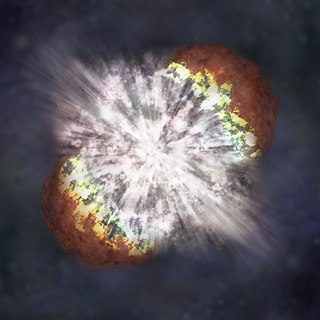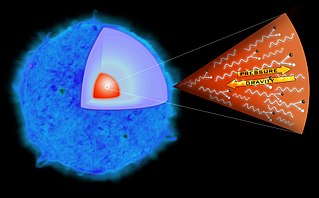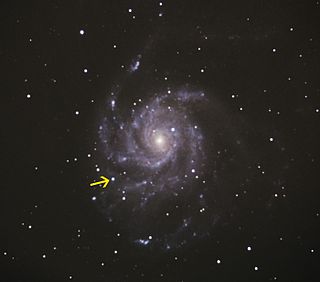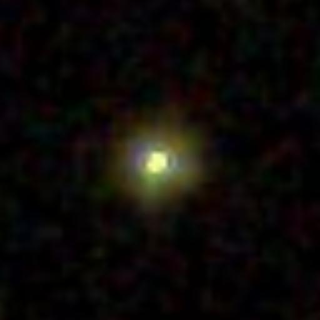
A supernova is a powerful and luminous explosion of a star. A supernova occurs during the last evolutionary stages of a massive star or when a white dwarf is triggered into runaway nuclear fusion. The original object, called the progenitor, either collapses to a neutron star or black hole, or is completely destroyed to form a diffuse nebula. The peak optical luminosity of a supernova can be comparable to that of an entire galaxy before fading over several weeks or months.

A magnetar is a type of neutron star with an extremely powerful magnetic field (~109 to 1011 T, ~1013 to 1015 G). The magnetic-field decay powers the emission of high-energy electromagnetic radiation, particularly X-rays and gamma rays.

A super-luminous supernova is a type of stellar explosion with a luminosity 10 or more times higher than that of standard supernovae. Like supernovae, SLSNe seem to be produced by several mechanisms, which is readily revealed by their light-curves and spectra. There are multiple models for what conditions may produce an SLSN, including core collapse in particularly massive stars, millisecond magnetars, interaction with circumstellar material, or pair-instability supernovae.

A stellar black hole is a black hole formed by the gravitational collapse of a star. They have masses ranging from about 5 to several tens of solar masses. The process is observed as a hypernova explosion or as a gamma ray burst. These black holes are also referred to as collapsars.

A near-Earth supernova is an explosion resulting from the death of a star that occurs close enough to the Earth to have noticeable effects on Earth's biosphere.

GRB 060218 was a gamma-ray burst with unusual characteristics never seen before. This GRB was detected by the Swift satellite on February 18, 2006, and its name is derived from the date. It was located in the constellation Aries.
SN 2003fg, nicknamed the Champagne Supernova, was an unusual Type Ia supernova. It was discovered in 2003, with the Canada-France-Hawaii Telescope and the Keck Telescope, both on Mauna Kea in Hawaii, and announced by researchers at the University of Toronto. The supernova occurred in a galaxy some 4 billion light-years from Earth. It was nicknamed after the 1995 song "Champagne Supernova" by English rock band Oasis.
Carbon detonation or carbon deflagration is the violent reignition of thermonuclear fusion in a white dwarf star that was previously slowly cooling. It involves a runaway thermonuclear process which spreads through the white dwarf in a matter of seconds, producing a type Ia supernova which releases an immense amount of energy as the star is blown apart. The carbon detonation/deflagration process leads to a supernova by a different route than the better known type II (core-collapse) supernova.

A Type II supernova or SNII results from the rapid collapse and violent explosion of a massive star. A star must have at least eight times, but no more than 40 to 50 times, the mass of the Sun (M☉) to undergo this type of explosion. Type II supernovae are distinguished from other types of supernovae by the presence of hydrogen in their spectra. They are usually observed in the spiral arms of galaxies and in H II regions, but not in elliptical galaxies; those are generally composed of older, low-mass stars, with few of the young, very massive stars necessary to cause a supernova.

SN 2006gy was an extremely energetic supernova, also referred to as a hypernova or quark-nova, that was discovered on September 18, 2006. It was first observed by Robert Quimby and P. Mondol, and then studied by several teams of astronomers using facilities that included the Chandra, Lick, and Keck Observatories. In May 2007 NASA and several of the astronomers announced the first detailed analyses of the supernova, describing it as the "brightest stellar explosion ever recorded". In October 2007 Quimby announced that SN 2005ap had broken SN 2006gy's record as the brightest-ever recorded supernova, and several subsequent discoveries are brighter still. Time magazine listed the discovery of SN 2006gy as third in its Top 10 Scientific Discoveries for 2007.

A pair-instability supernova is a type of supernova predicted to occur when pair production, the production of free electrons and positrons in the collision between atomic nuclei and energetic gamma rays, temporarily reduces the internal radiation pressure supporting a supermassive star's core against gravitational collapse. This pressure drop leads to a partial collapse, which in turn causes greatly accelerated burning in a runaway thermonuclear explosion, resulting in the star being blown completely apart without leaving a stellar remnant behind.

SCP 06F6 is an astronomical object of unknown type, discovered on 21 February 2006 in the constellation Boötes during a survey of galaxy cluster CL 1432.5+3332.8 with the Hubble Space Telescope's Advanced Camera for Surveys Wide Field Channel.

SN 2011fe, initially designated PTF 11kly, was a Type Ia supernova discovered by the Palomar Transient Factory (PTF) survey on 24 August 2011 during an automated review of images of the Messier 101 from the nights of 22 and 23 August 2011. It was located in Messier 101, the Pinwheel Galaxy, 21 million light years from Earth. It was observed by the PTF survey very near the beginning of its supernova event, when it was approximately 1 million times too dim to be visible to the naked eye. It is the youngest type Ia ever discovered. About 13 September 2011, it reached its maximum brightness of apparent magnitude +9.9 which equals an absolute magnitude of about -19, equal to 2.5 billion Suns. At +10 apparent magnitude around 5 September, SN 2011fe was visible in small telescopes. As of 30 September the supernova was at +11 apparent magnitude in the early evening sky after sunset above the northwest horizon. It had dropped to +13.7 as of 26 November 2011.
SN 2213-1745 was an extremely remote superluminous supernova (SLSN), which occurred in between November 2004 and June 2005. Its peak far-ultraviolet absolute magnitude reached −21.2, which was comparable to the total absolute magnitude of its host galaxy. The distance (redshift) to this supernova z=2.0458±0.0005 makes it one of the most remote supernova observed as of 2012. The luminosity of SN 2213-1745 evolved slowly over several years as it was still detectable in November 2006. Both the high luminosity and slow decay indicate that the supernova's progenitor was a star with an initial mass as high as 250 solar masses. The supernova explosion itself was likely a pair-instability supernova similar to the SN 2007bi event, with which it shares many similarities.

SN 1000+0216 was an extremely remote superluminous supernova (SLSN), which occurred in between June and November 2006 in the constellation Sextans. Its peak far-ultraviolet absolute magnitude reached −21.5, which exceeded the total absolute magnitude of its host galaxy. The distance (redshift) to this supernova z=3.8993 ± 0.0074 makes it the most distant supernova observed as of 2012. The luminosity of SN 1000+0216 evolved slowly over several years as it was still detectable in November 2008. Both the high luminosity and slow decay indicate that the supernova's progenitor was a very massive star. The supernova explosion itself was likely either a pair-instability supernova or a pulsational pair-instability supernova similar to the SN 2007bi event. It also had some similarities to the low redshift SN 2006gy supernova. Overall classification of SN 1000+0216 remains uncertain.

SDSS J001820.5–093939.2 or SDSS J0018−0939 for short is a star system approximately 1000 light-years away near the constellation Cetus.
A pulsational pair-instability supernova is a supernova impostor event that generally occurs in stars at around 100 to 130 solar mass (M☉), as opposed to a typical pair-instability supernova which occurs in stars of 130 to 250 M☉. Like pair-instability supernovae, pulsational pair-instability supernovae are caused by draining of a star's energy in the production of electron-positron pairs but, whereas a pair-instability supernova completely disrupts the star in a massive supernova, the star's pulsational pair-instability eruption sheds 10–25 M☉. This generally shrinks it down to a mass of less than 100 M☉, too small for electron-positron pair creation, where it then undergoes a core-collapse supernova or hypernova. It is possible that this is what occurred during the 1843 eruption of the primary star of the Eta Carinae star system although there is no substantial evidence supporting this.

Hen 2-428 is a planetary nebula with a binary double white dwarf system core. This core star system is the first discovered candidate for Type Ia supernova through binary white dwarf merger process. At the time of its discovery, the star system at the core was the heaviest known double white dwarf binary star system.

A hypernova is a very energetic supernova thought to result from an extreme core-collapse scenario. In this case, a massive star collapses to form a rotating black hole emitting twin astrophysical jets and surrounded by an accretion disk. It is a type of stellar explosion that ejects material with an unusually high kinetic energy, an order of magnitude higher than most supernovae, with a luminosity at least 10 times greater. They usually appear similar to a type Ic supernova, but with unusually broad spectral lines indicating an extremely high expansion velocity. Hypernovae are one of the mechanisms for producing long gamma ray bursts (GRBs), which range from 2 seconds to over a minute in duration. They have also been referred to as superluminous supernovae, though that classification also includes other types of extremely luminous stellar explosions that have different origins.
SN 2016aps is the brightest supernova explosion ever recorded. In addition to the sheer amount of energy released, an unusually large amount of the energy was released in the form of radiation, probably due to the interaction of the supernova ejecta and a previously lost gas shell.















